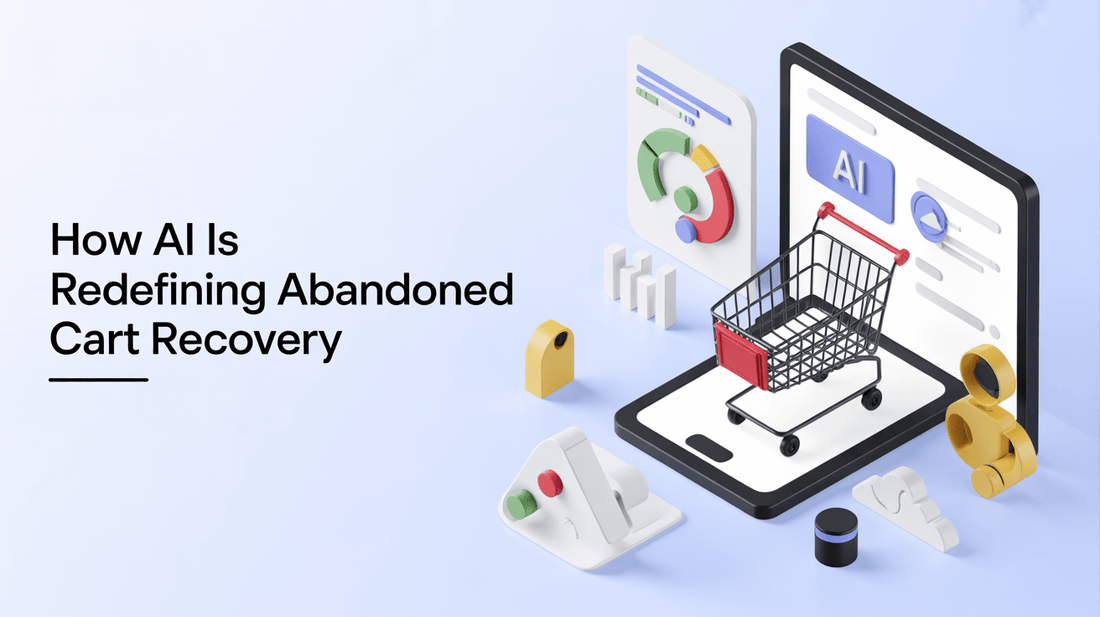
How AI Is Redefining Abandoned Cart Recovery
How AI Is Redefining Abandoned Cart Recovery: From Reminder Emails to Intelligent Customer Journeys
Introduction: The Hidden Leak in E-Commerce
Every online store owner knows the frustration of seeing “abandoned carts” piling up in analytics dashboards.
A customer clicks, browses, adds items to the cart… and then disappears. According to the Baymard Institute (2024), the global average cart abandonment rate is nearly 70.2%. That means seven out of ten shoppers leave before checking out — a massive leakage of potential revenue.
For years, the industry’s answer has been to send automated reminder emails: “Hey, you left something behind.” It works to a point.
Studies show that abandoned cart emails recover around 10% of lost sales (Klaviyo, 2023). But in a world where customers expect personalization and speed, a single reminder message isn’t enough.
This is where Artificial Intelligence is rewriting the playbook. Instead of static reminders, AI is creating dynamic recovery journeys that adapt to customer behavior in real time.
From Reminder to Relationship: Why AI Changes the Equation
Traditional recovery campaigns assume every shopper is the same. AI flips this assumption on its head.
By analyzing browsing patterns, purchase history, and even micro-behaviors like scroll depth or dwell time, AI can build an individualized profile of intent.
- If a shopper lingers on shipping options, AI can trigger a message about free delivery thresholds.
- If they abandoned after adding multiple sizes, AI can recommend the best-selling fit based on similar customers.
- If they clicked away during checkout, AI can offer one-click payment options to remove friction.
Instead of reacting with a single nudge, AI enables stores to anticipate the reason for abandonment and address it directly.
The Data Behind AI-Driven Recovery
The shift isn’t just theoretical. Retailers experimenting with AI-enhanced recovery are already seeing meaningful lifts:
- 35% increase in recovery rates when campaigns incorporate predictive personalization (Salesforce State of Marketing Report, 2024).
- 20–25% higher click-through rates on AI-generated abandoned cart emails compared to generic ones (Omnisend, 2023).
- Up to 30% improvement in customer lifetime value (CLV) when abandoned cart campaigns are paired with intelligent product recommendations (McKinsey, 2024).
Put simply, AI doesn’t just help you close one sale — it deepens engagement, turning a moment of hesitation into the start of a relationship.
Practical AI Tools for Abandoned Cart Recovery
You don’t need a Fortune 500 budget to implement these strategies. AI-driven personalization is becoming increasingly accessible:
Klaviyo AI – Generates adaptive subject lines and product recommendations for abandoned cart flows.
Shopify Inbox with AI integration – Provides real-time chat prompts to re-engage shoppers before they leave.
Drift & Intercom – AI chatbots that qualify intent and offer incentives (like discounts) directly in conversation.
RetentionX – Predictive analytics that identify which customers are worth chasing and how best to win them back.
These tools combine automation with intelligence: not just “send three emails” but “send the right message to the right person at the right time.”
Beyond Discounts: Crafting Intelligent Journeys
One of the biggest misconceptions is that abandoned cart recovery equals “offer a discount.” While incentives can work, they’re not sustainable at scale. AI helps retailers build non-discount recovery strategies that still convert:
Urgency messaging: “Low stock” alerts based on live inventory data.
Social proof: Highlighting customer reviews for the exact product in the cart.
Cross-channel nudges: Following up with a push notification or SMS if email isn’t opened.
Timing optimization: Sending the first reminder at the exact hour the customer is most likely to engage (based on past data).
This creates a holistic recovery flow that feels personal rather than pushy.

(Source: SalesCycle (2023), MoEngage (2024))
The Future: AI as a Conversion Co-Pilot
Looking forward, AI will not just recover abandoned carts but prevent them altogether. Imagine:
- A shopper hesitates at checkout → AI chat intervenes with reassurance about return policy.
- A customer adds items over budget → AI suggests bundled savings or installment payment options.
- A frequent buyer browses again → AI recognizes loyalty and pre-fills details for instant checkout.
Instead of waiting for abandonment to happen, AI becomes a co-pilot for conversion, reducing friction before the cart is ever abandoned.
Conclusion: Turning Abandonment into Opportunity
Abandoned carts will never disappear completely. Life interrupts, curiosity fades, and sometimes customers simply change their minds.
But for every cart left behind, there’s a chance to re-engage — and AI is giving retailers sharper, smarter tools to seize that chance.
The winners won’t be the stores that send the most reminders, but the ones that craft intelligent journeys tuned to each shopper’s unique behavior.
In an era where personalization drives loyalty, recovering an abandoned cart is more than a quick sale — it’s the first step in proving that your brand listens, understands, and values every customer.